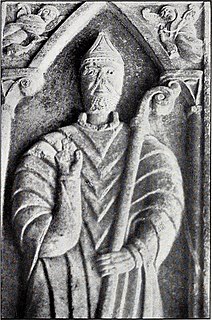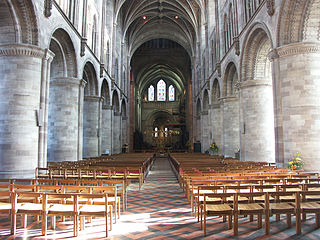Related Research Articles
Ralph d'Escures was a medieval abbot of Séez, bishop of Rochester and then archbishop of Canterbury. He studied at the school at the Abbey of Bec. In 1079 he entered the abbey of St Martin at Séez, and became abbot there in 1091. He was a friend of both Archbishop Anselm of Canterbury and Bishop Gundulf of Rochester, whose see, or bishopric, he took over on Gundulf's death.

Walter de Gray or Walter de Grey was an English prelate and statesman who was Archbishop of York from 1215 to 1255. He was Lord Chancellor under King John.
Geoffrey Ridel was the nineteenth Lord Chancellor of England, from 1162 to 1173.
Philip of Poitou was Bishop of Durham from 1197 to 1208, and prior to this Archdeacon of Canterbury.

Gisa was Bishop of Wells from 1060 to 1088. A native of Lorraine, Gisa came to England as a chaplain to King Edward the Confessor. After his appointment to Wells, he travelled to Rome rather than be consecrated by Stigand, the Archbishop of Canterbury. As bishop, Gisa added buildings to his cathedral, introduced new saints to his diocese, and instituted the office of archdeacon in his diocese. After the Norman Conquest, Gisa took part in the consecration of Lanfranc, the new Archbishop of Canterbury, and attended Lanfranc's church councils. His tomb in Wells Cathedral was opened in the 20th century and a cross was discovered in his tomb.
Henry Murdac was abbot of Fountains Abbey and Archbishop of York in medieval England,
Reginald fitz Jocelin was a medieval Bishop of Bath and an Archbishop of Canterbury-elect in England. A member of an Anglo-Norman noble family, he was the son of a bishop, and was educated in Italy. He was a household clerk for Thomas Becket, but by 1167 he was serving King Henry II of England. He was also a favourite of King Louis VII of France, who had him appointed abbot of the Abbey of Corbeil. After Reginald angered Becket while attempting to help negotiate a settlement between Becket and the king, Becket called him "that offspring of fornication, that enemy to the peace of the Church, that traitor." When he was elected as a bishop, the election was challenged by King Henry's eldest son, Henry the Young King, and Reginald was forced to go to Rome to be confirmed by Pope Alexander III. He attended the Third Lateran Council in 1179, and spent much of his time administering his diocese. He was elected Archbishop of Canterbury in 1191, but died before he could be installed.
Herbert Poore or Poor (died 1217) was a medieval English clergyman who held the post of Bishop of Salisbury during the reigns of Richard I and John.

The Bishop of Rochester is the ordinary of the Church of England Diocese of Rochester in the Province of Canterbury.
Thomas Cobham was an English churchman, who was Archbishop-elect of Canterbury in 1313 and later Bishop of Worcester from 1317 to 1327.
Simon Langton was an English medieval clergyman who served as Archdeacon of Canterbury from 1227 until his death in 1248. He had previously been Archbishop-elect of York, but the election was quashed by Pope Innocent III.
Roger de Clinton was a medieval Bishop of Coventry and Lichfield. He was responsible for organising a new grid street plan for the town of Lichfield in the 12th century which survives to this day.

Bartholomew Iscanus was a medieval Bishop of Exeter. He came from Normandy and after being a clerk of the Archbishop of Canterbury, was made Archdeacon of Exeter in 1155. He became bishop of Exeter in 1161. He was known as having excellence in canon law and theology and during his time as bishop visited all the parishes in the diocese to investigate how well-managed they were.
Henry Marshal was a medieval Bishop of Exeter.

Robert de Bethune was a medieval Bishop of Hereford. From a knightly family, he became a teacher before becoming a canon by 1115. He was elected prior of Llanthony Priory in the middle 1120s, and was named bishop by King Henry I of England in 1130. As bishop, he was often appointed a judge by the papacy, and was known for the care he took of his diocese.

John was a medieval Bishop of Rochester.
Waleran was a medieval Bishop of Rochester.
Gilbert Glanvill or Gilbert de Glanville was a medieval Bishop of Rochester.
Henry Sandford was a medieval Bishop of Rochester.
William of Northall was a mediaeval Bishop of Worcester.
References
- Bartlett, Robert C. (2000). England Under the Norman and Angevin Kings: 1075–1225. Oxford: Clarendon Press. ISBN 0-19-822741-8.
- British History Online Archdeacons of Canterbury accessed on 30 October 2007
- British History Online Bishops of Rochester accessed on 30 October 2007
- Fryde, E. B.; Greenway, D. E.; Porter, S.; Roy, I. (1996). Handbook of British Chronology (Third revised ed.). Cambridge: Cambridge University Press. ISBN 0-521-56350-X.
| Catholic Church titles | ||
|---|---|---|
| Preceded by Ascelin | Bishop of Rochester 1148–1182 | Succeeded by Waleran |
| | This article about an English bishop or archbishop is a stub. You can help Wikipedia by expanding it. |